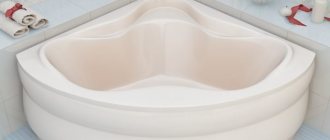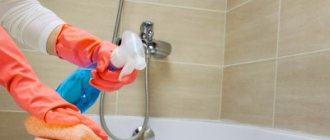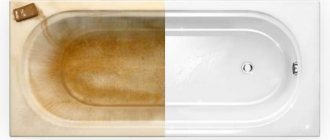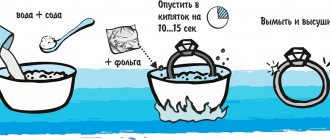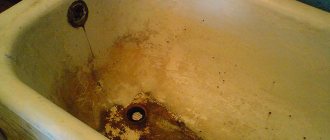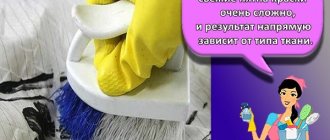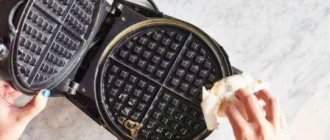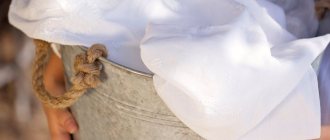Recently, a regular reader of our blog called Uborka-club and asked a question - how to clean an acrylic bathtub from yellowness and gray stains
The woman tried a lot of universal and specialized bath cleaning products.
At first they helped, but eventually the surface yellowed even more, and the gray coating became more contrasting. We recommended several cleaners and advised, if there is no result, to call our specialist or order restoration of the acrylic coating.
The telephone consultation inspired us to write this article. From it you will learn why an acrylic bathtub turns yellow or gray and what to do about it.
Available means
To clean an acrylic bathtub, you do not always need to buy expensive compounds. You can remove simple stains using available products.
Lemon acid
Citric acid works great against limescale. Use it as follows:
The bathtub needs to be filled with hot water. The maximum permissible temperature is 60 degrees.- Pour 2 bags of acid into the water and stir until completely dissolved.
- Leave the product to act for 2 hours.
- Rinse the bathtub with clean water, remove the residue with a dry cloth.
If the stains are not extensive, then citric acid is dissolved in a glass of water and applied to the stains with a sponge. After an hour, the solution is removed.
Toothpaste
Toothpaste whitens yellowness well and removes rust. Instructions for use:
- squeeze a small amount of paste onto the stain;
- spread it over the surface and leave for 15 minutes;
- Gently scrub the bathtub with an old soft-bristled toothbrush;
- rinse off the paste with water.
Ammonia
You can eliminate dark and yellow spots using ammonia and hydrogen peroxide.
Use the composition as follows:
- Mix alcohol and peroxide in equal proportions.
- Soak a sponge in the solution.
- Apply the composition to the contaminated areas and gently rub with a soft brush.
- Rinse the surface with clean water.
Soda
You can remove limescale and soap deposits using a soda solution. Mode of application:
- dilute baking soda with clean water until a paste forms;
- apply it to contaminated areas;
- leave for 15 minutes;
- rub with a sponge, rinse with water.
Apple vinegar
Apple cider vinegar is a safe way to remove simple stains. Use it as follows:
- Soak the sponge in vinegar.
- Apply it to the contaminated area.
- Leave to whiten for 15 minutes.
- Wash off the product with warm water.
Apple cider vinegar helps to cope not only with yellowness, but also with lime deposits.
Method 2: Pemolux gel
It is not recommended to clean acrylic with ordinary Pemolux powder, since it contains hard granules. But the gel from this series is great for acrylic.
Cleaning steps:
- A little gel is applied to the dirty area.
- After some time, remove with a sponge, wash with clean water and wipe with dry cotton cloth.
Special formulations
To clean an acrylic bathtub, you can use the following store-bought products:
Cinderella emulsion
This composition is intended for processing acrylic . After its use, a protective film is formed on the surface, and the bath acquires a characteristic shine. The composition is based on anionic and nonionic surfactants.
Before use, the bottle must be shaken thoroughly. To remove stubborn stains, leave the product on the surface for 10 minutes. The price of the bottle is 80 rubles.
Spray Unicum
It can be used to combat:
- rust,
- mold,
- soap and limescale deposits.
The composition is destructive to fungi, so it can be used for antiseptic treatment. The formula includes acids in acceptable concentrations and anionic surfactants.
The use of the product gives the bath its original shine and leaves behind a protective layer. Price – 200 rubles.
Sanfor gel Acrylight Professional
This gel effectively removes rust, limescale and soap deposits , and copes with unpleasant odors. Its formula is enhanced with citric acid and surfactants.
The product has an antibacterial effect. Price – 150 rubles.
The listed compositions can be purchased in retail stores, in departments with household chemicals, as well as in online markets.
Video about using the Sanelit cleaning product for cleaning acrylic bathtubs:
Removing water stone
If you live in an area where the water contains a lot of calcium, your problem is likely to be waterstone. You can wipe it off with a 9% vinegar solution. If the plaque is very thick, heat the vinegar and, after applying, leave it to act for about 15 minutes (for example, using a soaked cloth). Don't forget to rinse the bathtub with warm water.
Features of removing various contaminants
Depending on the type of contaminant, different compositions must be used. This allows for increased cleaning efficiency.
Limescale
You can get rid of limescale using citric or acetic acid . For processing, do not use an overly concentrated solution. If the layer is old, then for 1 glass of water you will need 1 packet of citric acid or 2 tablespoons of vinegar.
Apply the product to the stains and leave for 20 minutes. During this time, contaminants must be periodically moistened. Wash off the product with warm water. If necessary, repeat the procedure. If it was decided to use household chemicals, then it should contain citric or oxalic acid.
Soapy
You can get rid of soap scum using baking soda, vinegar and water. They are used as follows:
- Soda is diluted with water to form a paste and applied to the stains.
- Mix table vinegar and water in equal proportions in a spray bottle.
- The resulting solution is applied to dried soda and rubbed with a soft brush.
- Wash off the product with clean water.
If you don’t want to use improvised means, then you can purchase any universal composition that is designed for caring for acrylic bathtubs. All of them are able to remove soap scum.
Mold
Hydrogen peroxide helps fight mold. Use it as follows:
- soak a sponge with peroxide;
- treat areas where mold has appeared with it;
- leave for an hour;
- carry out repeated processing;
- wash off the composition with hot water.
In addition to the fact that the pharmaceutical preparation will destroy the fungus, it will also whiten the yellowed areas. When choosing store-bought formulations, you need to purchase a product labeled “antibacterial.”
Yellowness
To get rid of yellowness, you can use the following means:
- A mixture of soda ash and baking soda. They are combined in equal proportions, applied to the yellow areas and filled with table vinegar. After an hour, the product is washed off.
- Ammonia. It will take at least half an hour to have an impact. All this time, the door to the bathroom must be open.
- A mixture of washing powder with bleach and grated laundry soap. The components are diluted with water to a paste-like state and applied to the yellowed areas for an hour.
- Hydrogen peroxide. It has pronounced whitening properties.
Yellow rust stains
You can get rid of rust with Coca-Cola. This unique product will not damage acrylic, but will perfectly dissolve rust.
Use it as follows:
- the bath is rinsed with water and dried;
- apply cola to a rag and apply it as a compress to rusty stains;
- As the rag dries, it needs to be moistened;
- After 3 hours, the bath is rinsed with clean water.
During this time, the rust will dissolve and be easily washed off from the surface being treated.
Causes of spots
In order to answer your question, let's look at the reasons why an acrylic bathtub turns yellow:
- An acrylic bathtub turns yellow due to poor quality manufacturing. In this case, it is best to restore the bath yourself, or contact a specialist.
- The bathtub has turned yellow due to improper care or lack thereof. In this case, you can try to clean it with detergents.
In order to better understand how to clean an acrylic bathtub, consider the properties of the material with which it is covered.
Information: Acrylic is a hard plastic and therefore does not corrode. But it also has disadvantages. The biggest disadvantage is that acrylic is susceptible to mechanical stress and is easy to scratch. For such baths, you cannot use detergents containing chlorine, ammonia, or acid.
Acrylic is also afraid of boiling water, acetone, and gasoline. We also very often see yellow spots on an acrylic bathtub, which is a consequence of a leaking faucet.
Choosing a cleaning product
To clean an acrylic bathtub, we will have to purchase a cloth or soft sponge (we said above that acrylic is easily scratched), as well as detergents. Let's look at some of them:
- Sif - this product is suitable for almost the entire bathroom, and does not contain abrasive substances. It cleans the bathtub perfectly, you can clean the taps and tiles. To clean the bathtub, you need to spray it for a few minutes and then rinse off.
- Acrilan is a foam intended for cleaning showers and bathtubs. It perfectly cleanses soap stains, as well as rust, plaque, various fungi, and old stains. This product also prevents the appearance of limescale, thanks to the film that forms after washing.
Important! Acrylan should only be used with rubber gloves and stored out of the reach of children.
- Bass is a product for everyday use. The product is used in liquid form.
- Tim-pro is a product whose direct purpose is to clean acrylic surfaces. It cleans heavily soiled areas well, while being environmentally friendly, and also removes unpleasant odors. At the same time, it creates a coating that has dirt-repellent properties.
- Cinderella is a relatively inexpensive, yet quite effective, cleaner for acrylic bathtubs. But it also has a pungent odor. Considering that the product is an aerosol, it is appropriate to use it in hand and respiratory protection equipment. Then wait 7 minutes after spraying, and the bath will need to be rinsed with cold water from the tap and the bathroom should be allowed to air out.
- Cleaner - this product has a special formula that allows you to effectively clean acrylic bathtubs, tiles, faucets from limescale, soap stains, grease, and corrosive deposits. This product has an acrylic polymer that repels dirt, as well as an antibacterial and antifungal composition.
What can't be used and why?
To wash an acrylic bathtub, you cannot use the following products:
- Acetone. It can lead to thinning of the acrylic layer and rapid wear of the bathtub.
- Abrasive substances. This applies not only to cleaning powders, but also to regular soda. It can only be used in diluted form. The use of abrasive compounds contributes to the appearance of scratches.
- Highly concentrated acids, for example, vinegar essence.
- Paint thinners, gasoline.
- Boiling water. To prevent acrylic from cracking, the water temperature should not exceed 60 degrees.
- Chlorine and cleaning products based on it. Its use leads to the formation of pores, which reduces the service life of the product.
- Formaldehyde. These substances are not only toxic, but also completely incompatible with acrylic.
Characteristics of acrylic bathtubs that should be considered before cleaning them
The acrylic-coated bathtub has water-repellent properties. It has no pores, so it hardly absorbs pollutants. Acrylic is highly durable, but it is still susceptible to wear and scratches. You should not clean an acrylic bathtub at home with highly abrasive detergents.
Exposure to acid and alkali leads to degradation of the coating structure. Do not wash bathtubs and acrylic shower trays with products containing aggressive chemicals. They help to quickly clean the surface white, but there is a high probability of damage.
Helpful information
Tips for caring for an acrylic bathtub:
When using any chemicals, rinse with cool, not hot, water. At high temperatures they increase their activity and can cause damage to acrylic.- Before using a detergent, you should carefully study its composition. It should not contain components that can destroy acrylic.
- You cannot mix several formulations at once unless indicated in the recipe. Multicomponent substances can accelerate the deterioration of the product.
- When washing the bathtub, you need to take care of the safety of the skin of your hands by protecting them with gloves.
All the most important and useful information about cleaning the bathroom is collected in this section of the site.
How to fix the situation if the bathtub is still damaged
If you do not place basins, stools and other hard objects on the bottom of the product, then scratches will not form. The same applies to the use of care products. But what to do if damage does appear?
Don't panic and call specialists. You can easily cope with some problems yourself.
- Small scratches, the depth of which is no more than 0.5 mm, can be polished with a regular piece of felt. If you do not need to treat the entire surface, then you will not need special tools and devices.
- Deep scratches can be easily removed using liquid acrylic.
Buy a repair kit consisting of a tube of this substance and a special plastic spatula. Apply acrylic to the damaged area, and after drying, polish it with a piece of felt. Repair kit for restoring acrylic coating - Even if there is a through hole in the bathroom, you can fix it. We are talking about products made from sheet acrylic. Attach tape to the back of the hole and pour liquid acrylic into the damage. You can also use a special insert insert.
For a white bath it will be easy for you to choose the appropriate product
If the product is made in color, pay attention to the shade markings, it will help you choose the right acrylic for restoration
